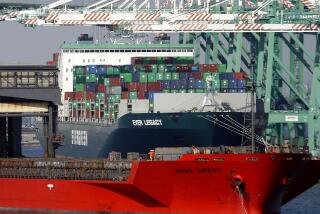Cotton Dealers to Reap Millions in Subsidies
- Share via
WASHINGTON — The 1985 farm law was propelled through Congress by the well-publicized struggles of family farmers, but it will send millions of dollars to middlemen who do no farming and live far from the Grain Belt.
Today, hundreds of cotton merchants, textile mills and cooperatives become eligible for payments that in some cases will reach tens of millions of dollars, according to government and industry sources. Some could get government subsidies worth $50 million or so.
Under the law, anyone holding “free stocks”--bales of old-crop cotton unencumbered by government loans--on this day will be entitled to one-time “inventory protection” payments of about $200 for each 500-pound bale.
Holders of eligible cotton will receive government commodity certificates that can be sold or exchanged for cotton now in government stocks.
Memphis, Tenn., the home of the cotton industry’s largest merchants, may also be the home for some of the heftiest federal subsidies.
Merchants such as Billy Dunavant and Hohenberg Bros. Cotton Co. are among the likely recipients of large federal payments to compensate them for the expected drop in value of accumulated cotton stocks.
Could Get $50 Million
“It wouldn’t surprise me if some of them don’t have 250,000 bales,” said one veteran industry watcher, who spoke on condition he not be identified. At $200 a bale, that could mean payments of up to $50 million to some cotton middlemen.
Precise figures on cotton holdings are regarded as competitive secrets, and Dunavant declined to talk specifically about how much he stands to collect. But he acknowledged that 250,000 bales is “in the ballpark.”
“We’ve got tremendous shipments to meet in August and September, and we’ve got to be in a position to roll,” he said.
“Yes, it’s going to be costly for the American government,” Dunavant added. “But 90% of the cotton grown in the world is grown under a subsidy. We’ve got to do this if we’re going to compete.” He said the entire cotton industry, from farmer to textile mill, will benefit from higher sales.
Hohenberg President Rudy Scheit said his firm is “not anywhere near” the $50-million figure but declined to be more specific.
Many merchants have been buying cotton at a rapid rate in recent weeks in anticipation of a surge in export sales after a new federal pricing policy takes effect today. The policy is aimed at getting U.S. prices down to levels that will be more competitive in world markets.
The largest recipients, in addition to the Memphis merchants, are likely to include textile makers such as Burlington, Cone, West Point Pepperell and Fieldcrest Cannon. Substantial amounts also may go to large cooperatives like Calcot in California, Southwestern Irrigated Growers and Plains Cotton in Texas and Staple Cotton in Mississippi.
For Short Duration
“The costs are going to be fairly high up front, but of relatively short duration,” said Dabney Wellford, a spokesman for the Memphis-based National Cotton Council.
“Well before the five years of this bill elapse, the situation will have been brought pretty much back into balance and government costs will have been greatly reduced, if not eliminated,” Wellford added.
The new law is proving to be the most expensive farm bill ever. Aimed at regaining lost U.S. export markets, it slashes commodity prices to more competitive levels while forking out massive subsidies to shield farmers and others from the blow.
“These payments are not a giveaway,” Scheit said. “It’s an indemnity for (the government’s) keeping the damn price above the world price the last 18 months. . . . We can’t keep it in our pockets, although I wish we could.”
While the payments may not be a windfall, middlemen wouldn’t have bought up old-crop cotton if they didn’t see an opportunity to turn a profit. “They’re in business to do that,” noted an Agriculture Department official, speaking on condition he not be identified.
More to Read
Inside the business of entertainment
The Wide Shot brings you news, analysis and insights on everything from streaming wars to production — and what it all means for the future.
You may occasionally receive promotional content from the Los Angeles Times.










